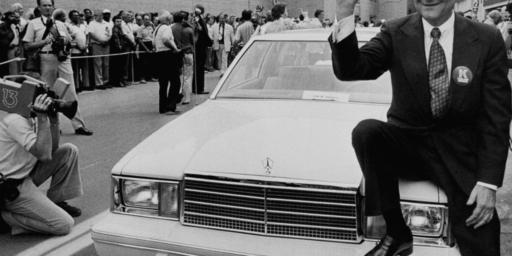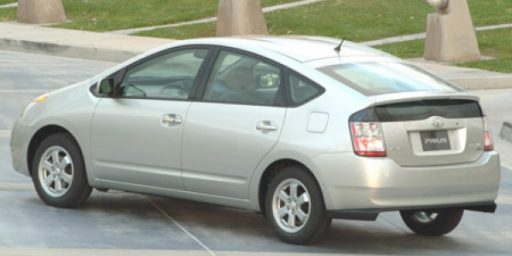General Motors: We Need Level Playing Field
GM chairman and CEO Rick Wagoner whines about having to compete with Japan in an OpinionJournal op-ed.
Since mid-October, General Motors has announced plans to cease production at 12 North American manufacturing facilities and eliminate 30,000 jobs by 2008; trim $1 billion in net material costs in 2006; and, in cooperation with the United Automobile Workers, reduce GM’s retiree health-care liabilities by $15 billion, or about 25%, for an annualized expense reduction of $3 billion.
The reason for these dramatic actions is no secret: GM has lost a lot of money in 2005, due to rapidly increasing health-care and raw-material costs, lower sales volumes and a weaker sales mix–essentially, we’ve sold fewer high-profit SUVs and more lower-profit cars. What is less clear is why things turned sour so fast for GM, as well as for other American auto makers and suppliers. To put it another way, why are so many foreign auto makers and suppliers doing well in the United States, while so many U.S.-based auto companies are not?
Why, unfair competition, of course:
So what are the fundamental challenges facing American manufacturing? One is the spiraling cost of health care in the United States. Last year, GM spent $5.2 billion on health care for its U.S. employees, retirees and dependents–a staggering $1,525 for every car and truck we produced. And the figure is going up again this year. Foreign auto makers have just a fraction of these costs, because they have few, if any, U.S. retirees, and in their home countries their governments fund a much greater portion of employee and retiree health-care costs.
Some argue that we have no one but ourselves to blame for our disproportionately high health-care “legacy costs.” That kind of observation reminds me of the saying that no good deed goes unpunished. That argument, while appealing to some, ignores the fact that American auto makers and other traditional manufacturing companies created a social contract with government and labor that raised America’s standard of living and provided much of the economic growth of the 20th century. American manufacturers were once held up as good corporate citizens for providing these benefits. Today, we are maligned for our poor judgment in “giving away” such benefits 40 years ago.
Another factor beyond our control is lawsuit abuse. Litigation now costs the U.S. economy more than $245 billion a year, or more than $845 per person. That’s more than 2% of our GDP. No other country has costs anywhere near this level. And the perverse thing is that, in many cases, the majority of courtroom settlements go to the lawyers and other litigation costs, not to the injured parties.
Another major concern is unfair trading practices, especially Japan’s long-term initiatives to artificially weaken the yen. A leading Japanese auto maker reports that for each movement of one yen against the dollar, it gains 20 billion yen in additional profitability–or nearly $170 million at today’s exchange rate. No wonder Japanese auto makers have noted their recent record profits were aided by exchange rates. And no wonder the U.S. trade-balance deficit continues to grow by leaps and bounds.
There are other issues, of course, but my point is this: We at GM have a number of tough challenges that we must and will address on our own–but we also carry some huge costs that our foreign competitors do not share.
Some say we’re looking for a bailout. Baloney–we at GM do not want a bailout. What we want–after we take the actions we are taking, in product, technology, cost and every area we’re working in our business today–is the chance to compete on a level playing field. It’s critical that government leaders, supported by business, unions and all our citizens, forge policy solutions to the issues undercutting American manufacturing competitiveness. We can do this. And we need to do it now.
There’s just one itty bitty problem with this argument: Most Japanese cars sold in the United States are made in the United States by American workers.
James Womack, responding to similar whining by Ford chairman Bill Ford, explains,
Consider a few facts about Toyota. About 65 percent of the vehicles the firm sells in North America it assembles in North America, and it would assemble a much higher proportion here if it could only keep up with its rapid sales growth. Toyota will open its seventh North American assembly line in Texas next summer and an eighth line in Ontario in 2008. It may start assembling vehicles at a Subaru plant in Indiana in 2009, and it is said to be looking for yet another assembly location. In addition, it has three engine manufacturing plants and is looking for a site for a fourth. By the end of the decade, Toyota will be able to assemble about as many cars as Chrysler does in North America, and it is closing in on the capacity Ford will have after plant closings that are widely expected to be announced in January.
[…]
he Big Three’s hold on the U.S. market seemed so secure by 1948, that they struck a deal with the United Auto Workers that added a new element to the Detroit system: high wages and generous benefits. The car-making business had become a tight oligopoly, with investment barriers for entry so high that no domestic firm could afford to join the club. On the labor side, the UAW held a monopoly. Thanks to rising demand for cars, there were plenty of profits to go around. Periodically the three vertically integrated companies and the union engaged in a bargaining ritual to determine how to split the loot. As long as improvements in mass-production offset the ever-higher wage rates by reducing the number of labor hours per vehicle, the cost of cars for consumers held stable.
The threat to this cozy arrangement came when foreign firms started investing in U.S. production facilities, beginning with Honda in Ohio in 1982, followed by Toyota in a joint venture with GM in California in 1984, and then Toyota again in its massive Georgetown, Ky., complex in 1986. If any government helped the Japanese at that time, it was the American government. When the Reagan administration came up with the Voluntary Restraint Agreement in 1981, it limited the number of imported Japanese cars sold in the United States for a period of years. Because consumer demand for Japanese cars then was greater than the supply, profit margins on the cars Japanese firms were allowed to sell soared. The Japanese companies then used those enormous profits to invest in North American factories and develop pricier up-market brands such as Lexus.
The Japanese auto makers had an outlook different from that of the Big Three. The purveyors of the old Ford-GM-Chrysler-UAW system assumed that all production laborers in the industry, including workers making parts, should be paid the same rate. The corporate and union leaders further assumed that their position was impregnable and that they could promise to pay defined-benefit pensions and other benefits decades into the future. The architects of the new Toyota-Honda system assumed that production labor would be paid different rates, as it was everywhere else in the world. Final-assembly workers would receive a premium and less skilled employees of parts makers — not owned by the car companies — would work for prevailing market wages. These Japanese firms also assumed that in hyper-competitive markets, no company could commit to benefits decades ahead. Better to base pensions on defined contributions made during work years rather than by guaranteeing payments in the far future.
[…]
[T]he leading Japanese car companies are making more money than their U.S. competitors not only because of lower costs, but because their lean design, production and purchasing system is turning out vehicles so desirable that Toyota and Honda can charge much higher prices for products in the same segment of the market. Indeed, these Japanese companies are giving wages and health packages to current workers in North America similar to those provided by their U.S. rivals, but they’re selling vehicles today for $2,500 more than comparably equipped cars made by Ford and GM. This revenue difference, more than the production cost issue, lies at the real heart of Motown’s problem.
Ford and GM have tried to embrace lean production methods, but as their market share shrinks, the legacy of the past looms larger. The U.S. firms need to shed large numbers of employees, but the main way to do that under “life-time employment” union contracts has been to encourage early retirement. This has solved one problem — too many active workers. But it created a second — too many retired workers for the active workers to support.
Wagoner’s defense of “no deed goes unpunished” is rather absurd. The fact that then-Big 3 automakers had a battle on their hands in the form of competition with Japanese cars was obvious even in the 1970s. That this was a permanent change was obvious to even the most casual observer once Honda began building its first plant here in 1982–over two decades ago now. That Ford and GM did not adapt to that changed business climate has nothing to do with goodness or fairness and everything to do with lousy management and greedy unions.
Furthermore, Japanese and German manufacturers operating in the United States have the same competitive issues as American-registered firms.* They, too, have to pay health care and retirement costs. They, too, are subject to lawsuits.
That American companies have to subsidize health care more than those in other countries is not really true, either. While the need for private insurance is obviated by a national health care system, the money to pay for either has to come from somewhere. In the United States, it comes in the form of direct payments by employers and employees. In Japan and Europe, it comes from the taypayers–i.e., firms and their employees.
*In a world of public companies and incredible integration of parts suppliers and investors, the extent to which Ford is more “American” than Honda is debatable.






Wagoner is indeed whining; GM continues to churn out crappy (both in styling and quality; Ford is the same to a lesser extent) cars. Rather than even trying to adopt a new business model, GM continues to rely on uninspired styling and centralized bean counters shortsheeting what might have been decent cars (like the Pontiac Fiero) into pieces of crap. Despite some successes at Cadillac (and former Chyrsler exec Bob Lutz at Pontiac), GM continues to be ruled by this ancient manufacturing model.
Contrast this with what’s going on at Chrysler: exciting new products such as the PT Cruiser, Chrysler 300, Dodge Charger and others. Chyrsler decided to give the people what they wanted and not the bean counters.
A retort they might offer is the Japanese plants are relatively new whereas the American plants have been here for several generations. What’s killing them is the fact they provide medical benefits to all the retirees, something the newer factory owners don’t have to contend with.
There’s another factor, of course…
The negotiated benefits/wage packages enjoyed by UAW workers is among the most generous in the world. That generosity comes with a price tag, of course. If health benefits alone add $1,500 to the price of a car, what about the rest of the benefits?
And yes, turning out comparative dreck does not make for a strong customer base.
fizzix: True, although only minimally. After all, had they fixed their pension plan in the late 70s or even early 80s, you’d be talking about a fairly small retiree population.
John: Yep. Of course, considering that even the American-made “Japanese” cars probably sell for $1500 more than their “American” competitors and are still beating them in sales, that only explains part of it.
Even funnier, back when they were producing the Geo Prism a join venture with Toyota was making Corollas at the same plant in Van Nuys California. The bitch of it was that both the Prism and the Corolla were built on the same frame, on the same assembly line with UAW workers and the Corolla sold for about 2k more then the Prisum.
Maybe they could stop making shitty cars?
Rick, I think you are referring to the NUMMI plant in Fremont, not Van Nuys. Now the Fremont plant is one of the two Corolla plants in North America (the other is in Ontario).
The problems, here are several;
Unions, Unions, Unions, Unions, Unions, Unions, Unions, Unions, Unions, Unions, Unions, Unions, Unions, Unions, Unions, Unions, Unions, Unions, Unions, Unions, Unions, Unions, Unions, Unions, Unions, Unions, Unions, and government.
You forgot quality, quality, quality, quality, quality, quality, and quality Bithead.
No, Fers, I didn’t.
I consider, rather, that the two issues are connected, thus;
Which is going to give you a better quality of output:
* SOmeone who has a job regardless of what happens
* Someone who has to work to impress, thereby keeping his job?
I don’t see how the unions at the Mercedes and BMW plants in Germany are making their cars any less desirable. Problem here is really bad management at GM. Ford made a great comeback in the 80s (did anyone read David Halberstam’s “The Reckoning?) but pissed it all away when it decided to put all its eggs in the SUV and truck basket.
You mean they actually dared to give the people what they wanted?
Paying semi-skilled and unskilled workers like professionals is their real problem. They also have given unions retirement plans that GM cannot possibly meet. First they give away their own checking account. Then they give away the taxpayers checking account. GM management should be going to jail for this frad.
GM’s problem now is same one afflicting many heavy industries – defined benefit plans. Many of these companies instituted these plans long time ago when they were much more labor-intensive. More workers could easily support a small number of retirees (with shorter lifespans.) But as these companies shed workers by modernizing facilities, it also meant fewer contributors to a defined-benefit plan. To top it off, retirees were living longer to boot (and medical cost skyrocketing).
These train wrecks are just going to keep piling up…..
The Fremont plant is, I believe, the only UAW plant that Toyota has. The union has threatened to strike a few times, but that would be a bad idea since Toyota would close that plant and move it down South if that happened. By the way, I have a new Nissan Frontier. It was $17,000. I got a $1500 rebate. Great truck. It’s made in Tennessee. The factory that makes them is the most productive auto plant in the US. The workers there have turned down UAW attempts to unionize them THREE times.
seems like everybody has 20/20 hind-sight on the pensions and health care.I guess Ford and GM should just build cars in India and China (where GM products sell quite well) and import them to the U.S. I think G.M. will survive but their major market will not be the U.S. in the next 5 years. It will be the working class in the U.S. that will be hurt the most.
GM has missed the boat! Those greedy little bean counters! How do they ever get management positions anyway? They are always so intraverted money money money numbers numbers numbers……………
I find it almost comical that no one talks about why GM has lost market share. As an engineer and a pre 80’s GM groupie it was tough when my wife brought home a new toyota pickup in 1995. We had words :). After 160,000 miles, maybe $100 in parts like oil filters and starter brushes and never a trip to the DEALER!! I will never drive anything but TOYOTA again. Thats not totally true, I am restoring a 55 Chevy 3100 NAPCO 4×4 stepside pickup for my oldest son. I would not however trade the 55 for a new GM vehicle(Maybe the vette).
Its offensive to see GM pay a perfectly intellegent engineer to redesign parts to fail after so many cycles. It would last too long! How can we make money on parts and service says the bean counter. How many times has a friend of mine asked me to fix their car and all I find is a wheel hub with an aluminum rounded tooth gear. It was made to strip, it’s worth the $2 they paid to have it made in China or Mexico and the PARTS GUY wants $300.
Just ask anyone who buys a Toyota. It’s not about the initial cost it’s ALL ABOUT THE QUALITY!!!!!!!!!!
Try a new MISSION STATEMENT:
Made in AMERICA
7 year bumper to bumper
Its not about the grille
new design with fewer parts
fail safe redundant electronics
They just don’t get it!
The Japanese and other foreign automakers are wooed by politicians that promise big incentives. Free land , huge subsidizing of the plant building, and other such ridiculous “frivolties” forthwith not mentioned.
Average American content is 80% in American autos, 31% in Japanese, and 5% in German.
And American auto manufacturers purchase 80% of all American auto parts.
Lastly, American auto manufacturers employ close to 90% of auto workers.
A few things I think should be included.
If Japanese car manfacturers are paying similar wages to General Motors, then how is it that the UAW is greedy Mr. Womack? It seems to me that it must be something else if these are equal. Maybe you have something with the management remark, I can’t say for sure. As for health care, yes, other countries pay for it through taxes but then don’t our corporations pay taxes AND heathcare costs? And we citizens pay taxes too, so maybe the government can spend those taxes on it citizens better?
Chris: U.S. tax rates, both corporate and individual, are a fraction of what the Japanese and Europeans pay.